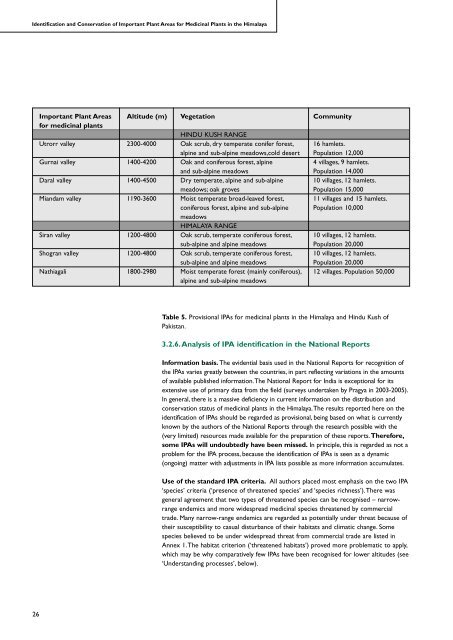Identification and Conservation of Important Plant Areas - Plantlife
Identification and Conservation of Important Plant Areas - Plantlife
Identification and Conservation of Important Plant Areas - Plantlife
- No tags were found...
You also want an ePaper? Increase the reach of your titles
YUMPU automatically turns print PDFs into web optimized ePapers that Google loves.
<strong>Identification</strong> <strong>and</strong> <strong>Conservation</strong> <strong>of</strong> <strong>Important</strong> <strong>Plant</strong> <strong>Areas</strong> for Medicinal <strong>Plant</strong>s in the Himalaya<strong>Important</strong> <strong>Plant</strong> <strong>Areas</strong> Altitude (m) Vegetation Communityfor medicinal plantsHINDU KUSH RANGEUtrorr valley 2300-4000 Oak scrub, dry temperate conifer forest, 16 hamlets.alpine <strong>and</strong> sub-alpine meadows,cold desert Population 12,000Gurnai valley 1400-4200 Oak <strong>and</strong> coniferous forest, alpine 4 villages, 9 hamlets.<strong>and</strong> sub-alpine meadows Population 14,000Daral valley 1400-4500 Dry temperate, alpine <strong>and</strong> sub-alpine 10 villages, 12 hamlets.meadows; oak groves Population 15,000Mi<strong>and</strong>am valley 1190-3600 Moist temperate broad-leaved forest, 11 villages <strong>and</strong> 15 hamlets.coniferous forest, alpine <strong>and</strong> sub-alpine Population 10,000meadowsHIMALAYA RANGESiran valley 1200-4800 Oak scrub, temperate coniferous forest, 10 villages, 12 hamlets.sub-alpine <strong>and</strong> alpine meadows Population 20,000Shogran valley 1200-4800 Oak scrub, temperate coniferous forest, 10 villages, 12 hamlets.sub-alpine <strong>and</strong> alpine meadows Population 20,000Nathiagali 1800-2980 Moist temperate forest (mainly coniferous), 12 villages. Population 50,000alpine <strong>and</strong> sub-alpine meadowsTable 5. Provisional IPAs for medicinal plants in the Himalaya <strong>and</strong> Hindu Kush <strong>of</strong>Pakistan.3.2.6.Analysis <strong>of</strong> IPA identification in the National ReportsInformation basis. The evidential basis used in the National Reports for recognition <strong>of</strong>the IPAs varies greatly between the countries, in part reflecting variations in the amounts<strong>of</strong> available published information.The National Report for India is exceptional for itsextensive use <strong>of</strong> primary data from the field (surveys undertaken by Pragya in 2003-2005).In general, there is a massive deficiency in current information on the distribution <strong>and</strong>conservation status <strong>of</strong> medicinal plants in the Himalaya.The results reported here on theidentification <strong>of</strong> IPAs should be regarded as provisional, being based on what is currentlyknown by the authors <strong>of</strong> the National Reports through the research possible with the(very limited) resources made available for the preparation <strong>of</strong> these reports. Therefore,some IPAs will undoubtedly have been missed. In principle, this is regarded as not aproblem for the IPA process, because the identification <strong>of</strong> IPAs is seen as a dynamic(ongoing) matter with adjustments in IPA lists possible as more information accumulates.Use <strong>of</strong> the st<strong>and</strong>ard IPA criteria. All authors placed most emphasis on the two IPA‘species’ criteria (‘presence <strong>of</strong> threatened species’ <strong>and</strong> ‘species richness’).There wasgeneral agreement that two types <strong>of</strong> threatened species can be recognised – narrowrangeendemics <strong>and</strong> more widespread medicinal species threatened by commercialtrade. Many narrow-range endemics are regarded as potentially under threat because <strong>of</strong>their susceptibility to casual disturbance <strong>of</strong> their habitats <strong>and</strong> climatic change. Somespecies believed to be under widespread threat from commercial trade are listed inAnnex 1.The habitat criterion (‘threatened habitats’) proved more problematic to apply,which may be why comparatively few IPAs have been recognised for lower altitudes (see‘Underst<strong>and</strong>ing processes’, below).26
















